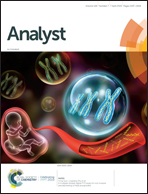One-step sensing of foodborne pathogenic bacteria using a 3D paper-based device†
Abstract
Managing food contamination from bacteria has been an ongoing issue in the public health and industrial fields. Enzymatic substrates possessing optical properties, e.g. fluorescence or color manifestation, are widely exploited in pathogenic/non-pathogenic bacteria culture methods. Recently, various chromogenic substrates have been utilized in the development of point-of-care diagnostic tools. Herein, four types of chromogenic substrates were exploited to develop paper-based sensors for major foodborne pathogens. We designed a compact sized three-dimensional paper device with a simple user interface. By inserting functional layers in the middle of multilayers, pre-lysis and pH regulation steps were excluded and the analysis time was subsequently reduced, while only one sample droplet was needed for the whole analysis process. After the enzymatic reactions had proceeded, target-specific colors appeared. When it was combined with enrichment, 101 cfu mL−1 of pathogens were successfully detected in 4–8 hours, while those in milk samples were readily sensed in 12 hours. The proposed bacteria sensor exhibited great advantages of low cost, portability and simple operation, while showing a respectable limit-of-detection as low as 101 cfu mL−1 and below. Significantly, we emphasize that it takes fewer steps than existing methods and provides a reduced analysis time owing to the layer functionalization.



 Please wait while we load your content...
Please wait while we load your content...